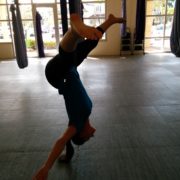5 Intention-setting Ideas to Support the Development of Santosha
“Contentment is not the fulfillment of what you want, but the realization of how much you already have.”― Anonymous
I attended a workshop many years ago about letting go of my expectations as a way to reduce the stress of the holiday season. I remember thinking “Why would I ever want to lower my expectations?” It sounded like I was being asked to let go of my goals, which ran counterintuitive to my (at the time) Type A personality, but I was willing to try anything to avoid the inevitable pain that I came to experience when it came to this time of year. When I tried it out that year, the result was one of the best gifts I ever gave myself!
Now, fast forward to my present day experience, where I have loosened my grip on my attachment to my Type A personality traits, I set intentions instead of having expectations, and I trust that the Universe will co-create something even better than I every could imagine by myself. How did I get from point A to point B? Well, it hasn’t always been a straight line, yet one particular practice has proven invaluable, especially at this time of year. The practice is the development of Santosha, which is Sanskrit for contentment. And even though the human mind’s default position is to worry or focus on the negative because it is what keeps us safe when danger approaches, it doesn’t mean that we can’t flip the switch by seeking the beauty, harmony and peace in every experience.Now, I’m not going to tell you it is easy. It takes practice, just like any new sport or hobby you might want to take up. So, if the idea of expanding the sense of inner peace sounds appealing to you, below are some ideas to support the practice of Santosha and I recommend trying them out now BEFORE the holiday season is upon us!
- Let go of what you can’t control. When we really think about what is truly under our control, we quickly realize not too many things come to mind. To support the expansion of our awareness of this adage – or something similar like “letting go instead of holding on” – you might want to write it down and put near your tooth brush so you can remind yourself on a daily basis, even several times a day. As you allow this awareness to become more evident in your mind, also tune into the felt experience in the body too. When you feel the pain of disappointment or loss, the body is informing you that you were probably trying to control something out of your control and had attached expectations to the outcome. So try letting go of the need to control and the associated outcome expectations. Not only will you reduce the pain that naturally accompanies loss but you will reduce the experiences of disappointment altogether!
- Stop comparing yourself to others. When we spend our energy focusing on others, what they have that we want, we discount our own unique gifts and zap ourselves of the potential we have to live our dharma. Instead, shift your energy to focus on discovering, cultivating, and growing your own gifts and notice how much more vitality and peace you experience.
- Look for the silver lining. When we find ourselves stuck in a unhealthy or painful situation, it can be very difficult to tap into our reservoir of inner peace and contentment. In those moments, I suggest sitting for a moment and ask yourself “How might this situation be serving me?” Everything serves although it might take us a little while to figure it out. Sometimes we find ourselves in situations in order to learn what we don’t like or want in our lives, especially when it doesn’t bring us comfort. Use this information as a guide for moving forward in a different, more authentic direction for yourself.
- Develop discernment, don’t judge. Judgment can sometimes be a mask for expectations. We expect people to behave a certain way or to say certain things and when they don’t, we judge them. Judgment is very contagious and when we catch ourselves judging another, we start to realize how much judgment has seeped into our experience, where are thoughts are now judgments of ourselves! Instead, allow others to express themselves, however differently than you might express yourself, and consciously distinguish what is appropriate or inappropriate for you. When we bring consciousness to our thoughts, we open up to discernment and, with discernment we make healthy choices for ourselves and uplift the collective consciousness at the same time.
- Practice gratitude. Our social culture motivates us to spend a great deal of time, energy, and resources to create and generate, from simple ideas to literally concrete structures. However, our culture does not encourage us to spend an equal amount of time, energy, and resources in appreciating what we have achieved. This culture creates an imbalance and this imbalance disturbs our Santosha. Think about how much effort it requires to cook a meal for our families and how little time it takes to eat it so we can run to our next expectation or commitment. However, research has shown that if we took more time cultivating appreciation for what we already have, including the food we eat, we begin to expand our sense of contentment, bringing more inner peace into our minds and bodies and to the world.












